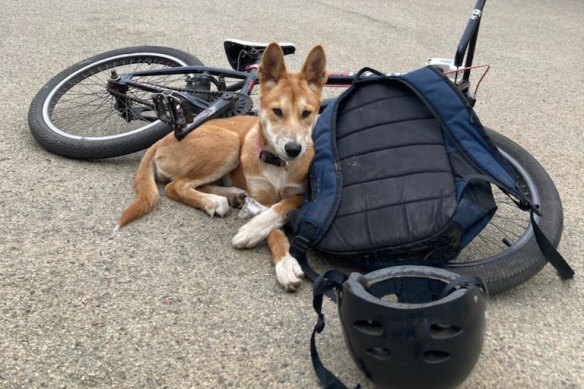By Linda Parri
A supermarket is one of the last places you’d expect to see a dingo.
But it’s where Bayswater resident Trent Emery and his son Wayde take their pure-breed dingo Bindi for their nightly shopping trip.

Three-month-old WA dingo Bindi likes to get away from it all.
“The shop owners don’t mind as long as I don’t put her on the ground,” Emery, a single father of two, said.
“Having a dingo is like having another child. They need to be with you 24 hours a day or they will become very stressed and mischievous. They’ll rip your house apart to get out, if left alone.”
Bindi mostly lives indoors, shares a bed with Emery, goes on regular camping trips and joins him at his job as a mechanical fabricator.
According to the WA Dingo Association, dingoes can be kept in Western Australia and NSW without a permit but are required to be registered and microchipped with local shires.
Permits are required in Victoria and the Northern Territory.
Emery has previously kept two rescue dingoes, Nitro and Mischief, who both lived until the age of 17.
He’s had Bindi since she was six weeks old, after obtaining her from a private owner.
Emery said people should not breed dingoes.
“They are not easy to get rid of and they go to wrong homes,” he said.

Bindi keeping fit.
“Having a dingo as a pet is a fad for some people, who just want ‘look at me’ status. They generally get euthanised or put in the pound or at rescue joints. Dingoes partner for life, so you want to make sure you have a forever home with the right lifestyle.”
Warren Painter, from Cross Roads Dingo Rescue, said he did not advocate keeping dingoes as pets.
“Once they get to about six to eight months old, they start getting their dingo in them,” he said.
“Even ones that have been born in a domestic market get to maturity at 3- 4 years old and they’ll kill your cat, even if they’ve been playing with it since they were a baby.”
Painter also discourages people from getting dingoes that have been cross-bred with dogs.
“Some people have been lucky, some people have not,” he said.
“We’d rather see them left in the wild.”
WA Dingo Association vice president Leigh Mullan describes people who keep dingoes as “guardians” rather than pet owners.
“They make terrible pets,” Mullan said.
“But in the right home, the right environment and with the right guardians, they can make the most amazingly rewarding, loving companions and a become valued member of the family.”
Mullan said dingoes were rarely trainable but were extremely intelligent.
“They are about as trainable as a cat,” she said.
“A cat in a dog suit with a monkey brain is how we would describe them. They are not the baby-eating monsters that public and media hysteria often tell us. They are not vicious or aggressive and favour flight over fight any day.”
Mullan said dingoes required an escape-proof yard as they could easily clear a two-metre fence, climb trees or dig their way out.
“It’s not a fear of escaping and harming anyone, the danger would be to the dingo in traffic,” Mullan said.
“Too many people in the past have gotten a dingo as a pet from some backyard breeder who has not provided any real information on the species’ unique care and containment requirements, and expected dog behaviour, only for it to escape and be killed on a local road.
“Or a year after they bought one, they have called us to rehome it because they had no idea how much effort they would be, or how destructive to the house and furniture they would be as a puppy.”
Mullan said many people in WA kept dingoes.
“Many of them come as orphans from up north where government baiting programs have killed the parents with 1080, leaving the pups to starve to death,” she said.
“Some come from interstate breeders and other rescues.
“Thankfully the backyard breeding in WA has stopped and calls to us to help rehome have calmed down.”